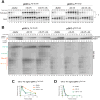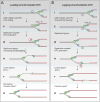Repair of a DNA-protein crosslink by replication-coupled proteolysis
- PMID: 25303529
- PMCID: PMC4229047
- DOI: 10.1016/j.cell.2014.09.024
Repair of a DNA-protein crosslink by replication-coupled proteolysis
Abstract
DNA-protein crosslinks (DPCs) are caused by environmental, endogenous, and chemotherapeutic agents and pose a severe threat to genome stability. We use Xenopus egg extracts to recapitulate DPC repair in vitro and show that this process is coupled to DNA replication. A DPC on the leading strand template arrests the replisome by stalling the CMG helicase. The DPC is then degraded on DNA, yielding a peptide-DNA adduct that is bypassed by CMG. The leading strand subsequently resumes synthesis, stalls again at the adduct, and then progresses past the adduct using DNA polymerase ζ. A DPC on the lagging strand template only transiently stalls the replisome, but it too is degraded, allowing Okazaki fragment bypass. Our experiments describe a versatile, proteolysis-based mechanism of S phase DPC repair that avoids replication fork collapse.
Copyright © 2014 Elsevier Inc. All rights reserved.
Figures







References
-
- Baker DJ, Wuenschell G, Xia L, Termini J, Bates SE, Riggs AD, O'Connor TR. Nucleotide Excision Repair Eliminates Unique DNA-Protein Cross-links from Mammalian Cells. Journal of Biological Chemistry. 2007;282:22592–22604. - PubMed
-
- Barker S, Weinfeld M, Murray D. DNA-protein crosslinks: their induction, repair, and biological consequences. Mutat Res. 2005;589:111–135. - PubMed
-
- Chen L, MacMillan AM, Chang W, Ezaz-Nikpay K, Lane WS, Verdine GL. Direct identification of the active-site nucleophile in a DNA (cytosine-5)-methyltransferase. Biochemistry. 1991;30:11018–11025. - PubMed
Publication types
MeSH terms
Substances
Grants and funding
LinkOut - more resources
Full Text Sources
Other Literature Sources
Miscellaneous

